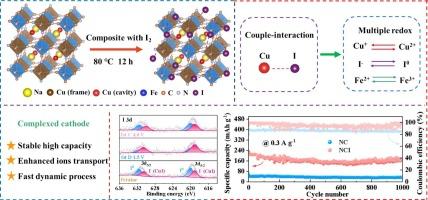钠金属电池用可逆cuI转换的铜基普鲁士蓝类似物/碘复合阴极
IF 9.7
1区 化学
Q1 CHEMISTRY, PHYSICAL
引用次数: 0
摘要
普鲁士蓝类似物(PBAs)凭借其独特的开放式框架结构、简单的合成和成本效益,成为钠金属电池阴极的有前途的候选材料。然而,由于氧化还原活性位点不足,PBAs的容量有限。此外,理论容量较高(21mah g−1)的碘阴极由于多碘离子的穿梭效应和动力学转化缓慢,实际性能较差。采用复合阴极构建转化反应可能是一种较好的方法,既能提高反应容量,又易于实现。在此,我们设计了一种铜基PBAs/碘复合阴极,其中PBAs框架作为碘宿主,并通过PBAs腔内的铜-碘偶联建立了转化反应机制以提高容量。各种表征结果表明,cu基PBAs框架能够实现良好的碘包封,促进CuI耦合,在充放电过程中实现可逆转换。密度泛函理论(DFT)模拟证实了cu基PBAs与碘的络合是一个热力学有利的过程。因此,组装的完整电池在0.1 a g−1下达到276.4 mAh g−1的高比容量,在0.3 a g−1下循环1000次后容量保持率为80.9%。本工作介绍了一种新型的cu基PBAs/碘络合转换阴极,为高性能钠金属电池的发展提供了创新的见解。本文章由计算机程序翻译,如有差异,请以英文原文为准。

Cu-based prussian blue analogs/iodine composite cathode with reversible cuI conversion for sodium metal batteries
Prussian Blue Analogs (PBAs) stood out as promising candidates for sodium metal batteries cathode, leveraging their unique open-framework architecture, straightforward synthesis, and cost-effectiveness. However, PBAs were plagued by limited capacity arising from insufficient redox-active sites. Additionally, iodine cathode with high theoretical capacity (211 mAh g−1) suffer from poor practical performance due to the shuttle effect of polyiodides and slow kinetic conversion. The complex cathode to construct conversion reaction might be a better method to improve the capacity and easy to implement. Herein, we reported the design of a Cu-based PBAs/iodine composite cathode, where the PBAs framework serves as an iodine host and a conversion reaction mechanism via copper‑iodine coupling within PBAs cavities was established to enhance capacity. Various characterization results demonstrated that the Cu-based PBAs framework enabled favorable iodine encapsulation and facilitated Cu![]() I coupling, enabling reversible conversion during charge/discharge progress. Density Functional Theory (DFT) simulations confirmed that the complexation of Cu-based PBAs with iodine represents a thermodynamically favorable process. Thereby, the assembled full battery achieved a high specific capacity of 276.4 mAh g−1 at 0.1 A g−1 and a capacity retention of 80.9 % after 1000 cycles at 0.3 A g−1. This work introduced a novel Cu-based PBAs/iodine complexed conversion cathode, offering an innovative insight for the development of high-performance sodium metal batteries.
I coupling, enabling reversible conversion during charge/discharge progress. Density Functional Theory (DFT) simulations confirmed that the complexation of Cu-based PBAs with iodine represents a thermodynamically favorable process. Thereby, the assembled full battery achieved a high specific capacity of 276.4 mAh g−1 at 0.1 A g−1 and a capacity retention of 80.9 % after 1000 cycles at 0.3 A g−1. This work introduced a novel Cu-based PBAs/iodine complexed conversion cathode, offering an innovative insight for the development of high-performance sodium metal batteries.
求助全文
通过发布文献求助,成功后即可免费获取论文全文。
去求助
来源期刊
CiteScore
16.10
自引率
7.10%
发文量
2568
审稿时长
2 months
期刊介绍:
The Journal of Colloid and Interface Science publishes original research findings on the fundamental principles of colloid and interface science, as well as innovative applications in various fields. The criteria for publication include impact, quality, novelty, and originality.
Emphasis:
The journal emphasizes fundamental scientific innovation within the following categories:
A.Colloidal Materials and Nanomaterials
B.Soft Colloidal and Self-Assembly Systems
C.Adsorption, Catalysis, and Electrochemistry
D.Interfacial Processes, Capillarity, and Wetting
E.Biomaterials and Nanomedicine
F.Energy Conversion and Storage, and Environmental Technologies

 求助内容:
求助内容: 应助结果提醒方式:
应助结果提醒方式:


